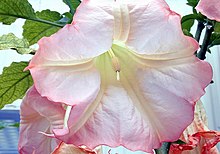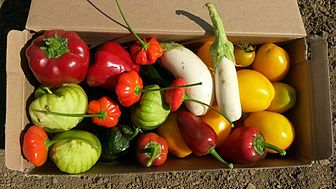 Global Information
Global InformationSolanaceae information
| Solanaceae Temporal range: Early Eocene to Recent,
| |
|---|---|

| |
| A flowering Brugmansia suaveolens from the US Botanic Garden | |
| Scientific classification | |
| Kingdom: | Plantae |
| Clade: | Tracheophytes |
| Clade: | Angiosperms |
| Clade: | Eudicots |
| Clade: | Asterids |
| Order: | Solanales |
| Family: | Solanaceae Juss. |
| Subfamilies[1] | |
| |

The Solanaceae (/ˌsɒləˈneɪsi.iː, -ˌaɪ/),[2] or the nightshades, are a family of flowering plants that ranges from annual and perennial herbs to vines, lianas, epiphytes, shrubs, and trees, and includes a number of agricultural crops, medicinal plants, spices, weeds, and ornamentals. Many members of the family contain potent alkaloids, and some are highly toxic, but many—including tomatoes, potatoes, eggplant, bell and chili peppers—are used as food. The family belongs to the order Solanales, in the asterid group and class Magnoliopsida (dicotyledons).[3] The Solanaceae consists of about 98 genera and some 2,700 species,[4] with a great diversity of habitats, morphology and ecology.
The name Solanaceae derives from the genus Solanum. The etymology of the Latin word is unclear. The name may come from a perceived resemblance of certain solanaceous flowers to the sun and its rays. At least one species of Solanum is known as the "sunberry". Alternatively, the name could originate from the Latin verb solare, meaning "to soothe", presumably referring to the soothing pharmacological properties of some of the psychoactive species of the family.
This family has a worldwide distribution, being present on all continents except Antarctica. The greatest diversity in species is found in South America and Central America. In 2017, scientists reported on their discovery and analysis of a fossil species belonging to the living genus Physalis, Physalis infinemundi, found in the Patagonian region of Argentina, dated to 52 million years ago. The finding has pushed back the earliest appearance of the plant family Solanaceae.[5]
The Solanaceae family includes a number of commonly collected or cultivated species. The most economically important genus of the family is Solanum, which contains the potato (S. tuberosum, in fact, another common name of the family is the "potato family"), the tomato (S. lycopersicum), and the eggplant or aubergine (S. melongena). Another important genus, Capsicum, produces both chili peppers and bell peppers.
The genus Physalis produces the so-called groundcherries, as well as the tomatillo (Physalis philadelphica) and Physalis peruviana (Cape gooseberry). Alkekengi officinarum (Chinese Lantern) was previously included in the genus Physalis (as Physalis alkekengi), until molecular and genetic evidence placed it as the type species of a new genus.[6][7] The genus Lycium contains the boxthorns and the goji berry, Lycium barbarum. Nicotiana contains, among other species, tobacco. Some other important members of Solanaceae include a number of ornamental plants such as Petunia, Browallia, and Lycianthes, and sources of psychoactive alkaloids, Datura, Mandragora (mandrake), and Atropa belladonna (deadly nightshade). Certain species are widely known for their medicinal uses, their psychotropic effects, or for being poisonous.[8]
Most of the economically important genera are contained in the subfamily Solanoideae, with the exceptions of tobacco (Nicotiana tabacum, Nicotianoideae) and petunia (Petunia × hybrida, Petunioideae).
Many of the Solanaceae, such as tobacco and petunia, are used as model organisms in the investigation of fundamental biological questions at the cellular, molecular, and genetic levels.[9][10]
- ^ "Solanaceae Juss., nom. cons". Germplasm Resources Information Network. United States Department of Agriculture. 2007-04-12. Retrieved 2009-04-16.
- ^ Lee, M. R. (June 2006). "The Solanaceae: foods and poisons". Journal of the Royal College of Physicians of Edinburgh. 36 (2): 162–169. ISSN 1478-2715. PMID 17153152.
- ^ Olmstead, R. G.; Sweere, J. A.; Spangler, R. E.; Bohs, L.; Palmer, J. D. (1999). "Phylogeny and provisional classification of the Solanaceae based on chloroplast DNA" (PDF). In Nee, M.; Symon, D. E.; Lester, R. N.; Jessop, J. P. (eds.). Solanaceae IV: advances in biology and utilization. The Royal Botanic Gardens. pp. 111–37.
- ^ Olmstead, R.G.; Bohs, L. (2007). "A Summary of molecular systematic research in Solanaceae: 1982-2006". Acta Horticulturae. 745 (745): 255–268. CiteSeerX 10.1.1.561.2269. doi:10.17660/ActaHortic.2007.745.11.
- ^ Wilf, Peter; Carvalho, Mónica R.; Gandolfo, María A.; Cúneo, N. Rubén (2017-01-06). "Eocene lantern fruits from Gondwanan Patagonia and the early origins of Solanaceae". Science. 355 (6320): 71–75. Bibcode:2017Sci...355...71W. doi:10.1126/science.aag2737. ISSN 0036-8075. PMID 28059765. S2CID 206651318.
- ^ "Alkekengi officinarum - Species Page - NYFA: New York Flora Atlas". newyork.plantatlas.usf.edu. Retrieved 2022-08-18.
- ^ "Plant database entry for Chinese Lantern (Alkekengi officinarum) with 35 images, 2 comments, and 26 data details". garden.org. Retrieved 2022-08-18.
- ^ Fatur, Karsten (June 2020). ""Hexing Herbs" in Ethnobotanical Perspective: A Historical Review of the Uses of Anticholinergic Solanaceae Plants in Europe". Economic Botany. 74 (2): 140–158. doi:10.1007/s12231-020-09498-w. ISSN 0013-0001. S2CID 220844064.
- ^ Niedbała, Gniewko; Niazian, Mohsen; Sabbatini, Paolo (2021). "Modeling Agrobacterium-Mediated Gene Transformation of Tobacco (Nicotiana tabacum)—A Model Plant for Gene Transformation Studies". Frontiers in Plant Science. 12: 695110. doi:10.3389/fpls.2021.695110. ISSN 1664-462X. PMC 8370025. PMID 34413865.
- ^ Gerats, Tom; Vandenbussche, Michiel (2005-05-01). "A model system for comparative research: Petunia". Trends in Plant Science. Special Issue: Plant model systems. 10 (5): 251–256. doi:10.1016/j.tplants.2005.03.005. ISSN 1360-1385. PMID 15882658.